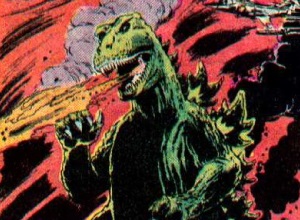

Godzilla vs. Marvel!
The 1970s saw a change in the comic book market (and ushered in what became known as the Bronze Age of Comics). The super-hero filled 1960s had come to a close, and some of the lesser-selling spandex titles were soon history. In their place began a long procession of experimentation and increased social relevance. And also a bunch of weirdo stuff. From drug addiction to villains headlining comics to werewolves and vampires, the Comic Code was becoming less restrictive, stories were becoming more daring and creative, and comics changed. Marvel began producing more licensed properties (Conan the Barbarian, Thongor of Lemuria, Star Wars, 2001: A Space Odyssey) and some horror titles (Ghost Rider, The Tomb of Dracula, Werewolf by Night) and reprints of older horror tales. All of these things helped shaped what becomes the subject of our series, the Godzilla comics.
Godzilla utilized a mix of existing Marvel characters and newly created ones to both integrate Godzilla into the Marvel universe, but also give it the feel of Godzilla movies. Not content to simply be a tale of a mindless beast destroying the land, Godzilla became something more. Godzilla was treated with respect, considered a force of nature with some degree of intelligence. At this time the Godzilla film series was on hiatus, but when it returned in 1984 with the Heisei films, this was essentially how Godzilla was treated. The trailblazing take still had references to the old. Godzilla did destroy things, people were injured and died in his chaos. Godzilla fought other monsters, many of which had more sinister desires than his own. Godzilla had human allies who understood him, but was also constantly being assaulted by random people who would shoot first and regret later (even super heroes fell into this trap!) By the end of the series, the goal became to contain Godzilla, not to stop him at all costs.
Through it all, we never get thought bubbles from Big G, but the narration does take a sympathetic tack when describing Godzilla’s actions, often giving him humanized emotions and responses (though occasionally making note that no one can know for certain!) Godzilla was a unique protagonist at the time, giving the comic a styling that would still be considered unusual.
Archie Goodwin shepherded the Godzilla series as the editor, with Doug Moench writing the entire series. Herb Trimpe was the main artist, though was assisted or on vacation for a few issues. The stable team helps keep Godzilla feeling like an actual ongoing story instead of some random collection of tales, and making Godzilla feel like a real character while having no dialogue except for monster growls. They also would have steered the comic in its more social conscious direction. Several of the earlier issues feature oil being a threatened resource, and mention the US’s addiction to oil (as they came out during the height of the oil embargo!) while other issues have environmental messages. Another shoutout to Trimpe’s art for not making the many minority cast members look like stereotypes. And on that note, 5 of the six main characters in Godzilla are non-White, which may be the highest percentage on an ensemble series I know of at that time.
The stories ranged the gauntlet from Godzilla battling invading space monsters to Godzilla wandering across a dude ranch to Godzilla being shrunk and then unshrunk. The variety of tales kept things from getting stale, and when there was monster action, it was often multiple monster action! Godzilla tore a path through the whole canon of creatures sent to combat him, with only one surviving the series (IIRC).
Godzilla survived the end of his series (which I think was more of a licensing thing than sales, though I am not certain) and continued to appear “unofficially”, though we’ll cover that in another post. The other lasting legacy from the Godzilla comic series was the robot creation Red Ronin, built to fight Godzilla and accidentally connected via brain control to a 12 year old boy, Robert Takiguchi, Godzilla sympathizer. Though Red Ronin would be damaged and taken out of action, it would appear in various Marvel series long after the Godzilla run had ended.
Godzilla is a pretty cool comic read, and I suggest you check it out sometime. Now let’s get dangerous and list everyone and everything that showed up in Marvel’s Godzilla!










